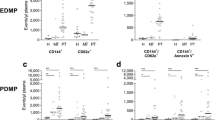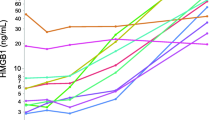Abstract
Introduction
Cell-free DNA (cfDNA) elevations were remarked in the blood of trauma patients. Published increases refer to comparative values of a healthy control group, ignoring thereby inter- and intra-individual differences under normal conditions. The aim of this study was to quantify cfDNA in patients in the time course of a planned orthopedic surgery, which constitutes the advantage of obtaining individual pre- and post-trauma values for each patient. By this approach, a basis should be established for the potential future application of cfDNA as biomarker for the detection of mild injuries related to volunteer experiments in forensic biomechanics.
Methods
Plasma samples of ten patients obtaining knee or hip arthroplasty were analyzed quantitatively for cfDNA by real-time qPCR the day prior operation (Prior), immediately afterwards (Day0), and the day after the surgery (Day1).
Results
Prior values exhibited a broad range, indicating pronounced inter-individual differences in the basic level of cfDNA. After surgery, levels were significantly elevated on both days (Wilcoxon test p = 0.002). In nine patients, highest values were measured on Day0, whereby a fold change of 19 was remarked once. After Day0, values decreased, though they did not reach Prior values until Day1 in nine patients.
Conclusion
Endoprosthesis surgery represents a well-defined trauma scenario for the measurement of individual cfDNA elevations. The analysis of pre- to post-trauma alterations lay the groundwork for the application of cfDNA as biomarker for the detection of minor injuries in the field of forensic biomechanics.



Similar content being viewed by others
References
Muggenthaler H, von Merten K, Peldschus S, Holley S, Adamec J, Praxl N, Graw M (2008) Experimental tests for the validation of active numerical human models. Forensic Sci Int 177(2–3):184–191
Bohnert M, Baumgartner R, Pollak S (2000) Spectrophotometric evaluation of the colour of intra- and subcutaneous bruises. Int J Legal Med 113(6):343–348
Lombardi M, Canter J, Patrick P a, Altman R (2015) Is fluorescence under an alternate light source sufficient to accurately diagnose subclinical bruising? J Forensic Sci 60(2):444–449
Rowan P, Hill M, Gresham G a, Goodall E, Moore T (2010) The use of infrared aided photography in identification of sites of bruises after evidence of the bruise is absent to the naked eye. J Forensic Legal Med 17(6):293–297
Helm T, Bir C, Chilstrom M, Claudius I (2016) Ultrasound characteristics of bruises and their correlation to cutaneous appearance. Forensic Sci Int 266:160–163
Timmermans K, Kox M, Vaneker M, van den Berg M, John A, van Laarhoven A, van der Hoeven H, Scheffer GJ, Pickkers P (2016) Plasma levels of danger-associated molecular patterns are associated with immune suppression in trauma patients. Intensive Care Med 42(4):551–561
Ren B, Liu F, Xu F, He J, Zhu H, Zou G (2013) Is plasma cell-free DNA really a useful marker for diagnosis and treatment of trauma patients? Clin Chim Acta 424:109–113
Macher H, Egea-Guerrero JJ, Revuelto-Rey J, Gordillo-Escobar E, Enamorado-Enamorado J, Boza A, Rodriguez A, Molinero P, Guerrero JM, Dominguez-Roldán JM, Murillo-Cabezas F, Rubio A (2012) Role of early cell-free DNA levels decrease as a predictive marker of fatal outcome after severe traumatic brain injury. Clin Chim Acta 414:12–17
Lam NY, Rainer TH, Chan LY, Joynt GM, Lo YM (2003) Time course of early and late changes in plasma DNA in trauma patients. Clin Chem 49(8):1286–1291
Lo YMD, Rainer TH, Chan LYS, Hjelm NM, Cocks RA (2000) Plasma DNA as a prognostic marker in trauma patients. Clin Chem 46(3):319–323
Thierry AR, El Messaoudi S, Gahan PB, Anker P, Stroun M (2016) Origins, structures, and functions of circulating DNA in oncology. Cancer Metastasis Rev 35(3):347–376
Wang W, Kong P, Ma G, Li L, Zhu J, Xia T, Xie H, Zhou W, Wang S (2017) Characterization of the release and biological significance of cell-free DNA from breast cancer cell lines. Oncotarget 8(26):43180–43191
Lee T, LeShane ES, Messerlian GM, Canick JA, Farina A, Heber WW, Bianchi DW (2002) Down syndrome and cell-free fetal DNA in archived maternal serum. Am J Obstet Gynecol 187(5):1217–1221
Lo DYM, Tein MSC, Lau TK, Haines CJ (1998) Quantitative analysis of fetal DNA in maternal plasma and serum: implications for noninvasive prenatal diagnosis. Am J Hum Genet 62(4):768–775
Wang C, Stanciu CE, Ehrhardt CJ, Yadavalli VK (2017) Nanoscale characterization of forensically relevant epithelial cells and surface associated extracellular DNA. Forensic Sci Int 277:252–258
Taki T, Kibayashi K (2015) Characterization of cellular and extracellular DNA in saliva. Leg Med (Tokyo) 17(6):471–474
McIlroy DJ, Bigland M, White AE, Hardy BM, Lott N, Smith DW, Balogh ZJ (2015) Cell necrosis-independent sustained mitochondrial and nuclear DNA release following trauma surgery. J Trauma Acute Care Surg 78(2):282–288
Wijeratne S, Butt A, Burns S, Sherwood K, Boyd O, Swaminathan R (2004) Cell-free plasma DNA as a prognostic marker in intensive treatment unit patients. Ann N Y Acad Sci 1022:232–238
Fox A, Gal S, Fisher N, Smythe J, Wainscoat J, Tyler MPH, Watt SM, Harris a L (2008) Quantification of circulating cell-free plasma DNA and endothelial gene RNA in patients with burns and relation to acute thermal injury. Burns 34(6):809–816
Shaked G, Douvdevani A, Yair S, Zlotnik A, Czeiger D (2014) The role of cell-free DNA measured by a fluorescent test in the management of isolated traumatic head injuries. Scand J Trauma Resusc Emerg Med 22(1):21
Rhodes A, Wort SJ, Thomas H, Collinson P, David ED (2006) Plasma DNA concentration as a predictor of mortality and sepsis in critically ill patients. Crit Care 10(2):1–7
Szpechcinski A, Chorostowska-Wynimko J, Kupis W, Maszkowska-Kopij K, Dancewicz M, Kowalewski J, Orlowski T (2012) Quantitative analysis of free-circulating DNA in plasma of patients with resectable NSCLC. Expert Opin Biol Ther 12(sup1):S3–S9
El Messaoudi S, Rolet F, Mouliere F, Thierry AR (2013) Circulating cell free DNA: preanalytical considerations. Clin Chim Acta 424:222–230
Mauger F, Dulary C, Daviaud C, Deleuze JF, Tost J (2015) Comprehensive evaluation of methods to isolate, quantify, and characterize circulating cell-free DNA from small volumes of plasma. Anal Bioanal Chem 407(22):6873–6878
Xie J, Yang J, Hu P (2018) Acute myocardial infarction patients show strong variations in circulating cell free DNA and correlated to clinical manifestations. Am J Med Sci 356:121–129
Biró O, Hajas O, Nagy-Baló E, Soltész B, Csanádi Z, Bálint N (2018) Relationship between cardiovascular diseases and circulating cell-free nucleic acids in human plasma. Biomark Med 12:891–905
Sanchis S, García-Blas S, Ortega-Paz L, Dantas AP, Rodrígues E, Abellán L, Brugaletta S, Valero E, Minana G, Garabito M, Corchón Á, Núnez J, Carratalá A, Sabaté M (2018) Cell-free DNA and microvascular damage in ST-segment elevation myocardial infarction treated with primary percutaneous coronary intervention. Rev Española de Cardiol (English Ed.). https://doi.org/10.1016/j.rec.2018.03.005
Wang L, Xie L, Zhang Q, Cai X, Tang Y, Wang L, Hang T, Liu J, Gong J (2015) Plasma nuclear and mitochondrial DNA levels in acute myocardial infarction patients. Coron Artery Dis 26(4):296–300
Chang CPY, Chia RH, Wu TL, Tsao KC, Sun CF, Wu JT (2003) Elevated cell-free serum DNA detected in patients with myocardial infarction. Clin Chim Acta 327(1–2):95–101
Lehmann-Werman R, Neiman D, Zemmour H, Moss J, Magenheim J, Vaknin-Dembinsky A, Rubertsson S, Nellgård B, Blennow K, Zetterberg H, Spalding K, Haller MJ, Wasserfall CH, Schatz DA, Greenbaum CJ, Dorrell C, Grompe M, Zick A, Hubert A, Maoz M, Fendrich V, Bartsch DK, Golan T, Ben Sasson SA, Zamir G, Razin A, Cedar H, Shapiro AMJ, Glaser B, Shemer R, Dor Y (2016) Identification of tissue-specific cell death using methylation patterns of circulating DNA. Proc Natl Acad Sci U S A 113(13):E1826–E1834
Zemmour H, Planer D, Magenheim J, Moss J, Neiman D, Gilon D, Korach A, Glaser B, Shemer R, Landesberg G, Dor Y (2018) Non-invasive detection of human cardiomyocyte death using methylation patterns of circulating DNA. Nat Commun 9(1):1443
Dietrich D (2016) Current status and future perspectives of circulating cell-free DNA methylation in clinical diagnostics. Lab Med 40(5):335–343
Acknowledgements
The authors would like to thank the whole medical personnel that helped with the sample collection as well as the staff at the institute of clinical chemistry at the Campus Grosshadern for their technical support.
Author information
Authors and Affiliations
Corresponding author
Ethics declarations
Conflict of interest
The authors declare that they have no conflict of interest.
Ethical approval
All procedures performed in the study were in accordance with the ethical standards of the institutional research committee and with the 1964 Helsinki declaration and its later amendments or comparable ethical standards.
Appendix
Appendix
Rights and permissions
About this article
Cite this article
Brodbeck, K., Kern, S., Schick, S. et al. Quantitative analysis of individual cell-free DNA concentration before and after penetrating trauma. Int J Legal Med 133, 385–393 (2019). https://doi.org/10.1007/s00414-018-1945-y
Received:
Accepted:
Published:
Issue Date:
DOI: https://doi.org/10.1007/s00414-018-1945-y




